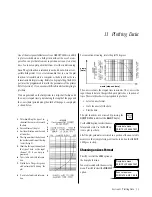
19
H = P
×
U / SG
where
H =
Head value
P =
Pressure in PSI
U =
Conversion units: 2.30667 feet of water/PSI or
0.703072 meters of water/PSI
SG =
Specific gravity (fluid density/water density)
Adjusting for Specific Gravity
If the working fluid is not water, you
can specify the fluid’s specific grav-
ity. Select the
SG
option from the
menus.
Key in the specific gravity and press
ENTER
. Use a value of 1 when work-
ing with water.
The display returns to the transducer
menus.
Note:
Some situations may require that you determine the fluid’s
specific gravity to obtain accurate test results. Such situations in-
clude monitoring in gasified wells and waters with salt-water intru-
sion or other contaminants.
Choosing a Level Mode
Press
F4
to select the
MODE
option
from the transducer menus.
You have a choice of
TOC
(top of
casing) or
SURFACE
level modes.
The current selection is shown in
brackets.
Use the
surface
mode to monitor
surface water situations such as
streams and lakes, or to use head
data directly.
Increasing
water lev-
els correspond to
increasing
level
readings.
Decreasing
water levels
correspond to
decreasing
level
readings.
Select the
top of casing
mode when
monitoring groundwater and read-
ings referenced to the top of the well
casing are required. In this case
decreasing
water levels correspond
to
increasing
top of casing read-
ings.
Increasing
water levels will
correspond to
decreasing
top of
casing readings.
Setting the Reference Level
Press
F3
to select the
REF
. option from
the transducer menus.
Key in a value for the reference level
and press
ENTER
.
The HERMIT 2000 will power up the
transducer and take a corresponding
reference head reading . . .
. . . and then return to the transducer
menu.
The transducer must be connected
and placed at its initial depth before
keying in the reference level.
The reference level is used to reference changes in head to changes
in an initial water level. The reference level is arbitrary and may be
set to any value suitable for the test conditions. When monitoring a
lake, for example, you might set the reference level at:
• The present depth of the lake with respect to the lake bottom so
that readings are presented as lake depth.
• The altitude of the lake surface so that readings are displayed as
altitudes.
• Zero, so that readings will reflect only changes, both positive and
negative, from the initial reference level.
Once the reference levels are set, the HERMIT 2000 can compute
surface levels as:
L(t) = R - [H(r) - H(t)]
Similarly, top of casing levels are computed as:
L(t) = R + [H(r) - H(t)]
where
L(t) = Level at time
R
= Reference level
H(r) = Head at time when reference level was entered
H(t) = Head at time t
Section 5: Setting Up Transducers
Input 2: Level (F)
DELAY SG UNITS MODE
SG [1]?
_
Input 2: Level (F)
DELAY SG UNITS MODE
Input 2: Level (F)
DELAY SG UNITS MODE
Mode [TOC]?
TOC SURFACE
Input 2: Level (F)
READ I.D. REF. more
Ref. [0]?
Not connected?
Ref. [0]?
Busy...
Input 2: Level (F)
READ I.D. REF. more
Ref. [0]?
_
CAUTION
Though the reference level is very flexible in definition, you
must select and enter a reference level for each level input,
with the transducers connected and set, before starting a
test.






























